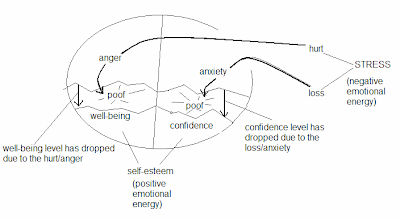In my last post titled The Rollercoaster, I described the full spectrum of emotional experience we go through as grievers. Tonight I'll complete the picture by explaining how to go from the low energy states to higher ones. It makes perfect sense when you think about it.
What causes the low energy states of anger and anxiety? In a word: stress. The stress can come from outside ourselves or from inside our mind. Let's look at another chart [pg 150]:
According to Dr Paul in his book MindOS™ - "The Operating System of the Human Mind", when the stress is external, anger comes from hurt, and anxiety comes from loss. Both impact our self-esteem. Is it any wonder, then, that as widow/ers, we suffer such a tremendous hit to our self-esteem? A double-whammy of hurt and loss, right between our eyes. Under normal circumstances, if we have a high-enough personal boundary, it can ward off external hurt and loss and can minimize the damage to our self-esteem. However, I believe that everyone is deeply affected by the loss of their spouse, regardless of how well-defined their personal boundary is. The stress is simply too overwhelming.
So, you might be thinking, it is all well and good to know this stuff, but how can I use it to feel better? How do I transform anger into well-being and anxiety into confidence?
First, it helps to understand that once stress is inside our boundary, it manifests in one of two ways: anger stems from our needs not being met, and anxiety arises from a loss of confidence and/or trust [pg 153]:
So, we see that the remedy for anger is to get our needs met, and the remedy for anxiety is to face our fears. I'm going to suggest that in the first year or so of grief, this is easier said than done!
Now that our spouse is dead, we face a huge laundry list of unmet needs. For example:
- Love
- Friends
- Income
- Freedom
- Creativity
- Leisure
And our confidence in ourselves, as well as our trust in God and the very foundations of the world, is shattered. Still, it is helpful to know what steps we need to take to feel better. The journey of the bereaved is one of slowly facing our fears and working towards getting our needs met. Like eating an elephant, we do this one little bite at a time.
For my next post, I'll conclude by showing the only possible reactions to both anger and anxiety, and that should complete our map of the roller coaster. When the next big downswing comes, you'll know exactly where you are. Where you go from there is up to you.



1 comment:
Appreciate your blogg post
Post a Comment